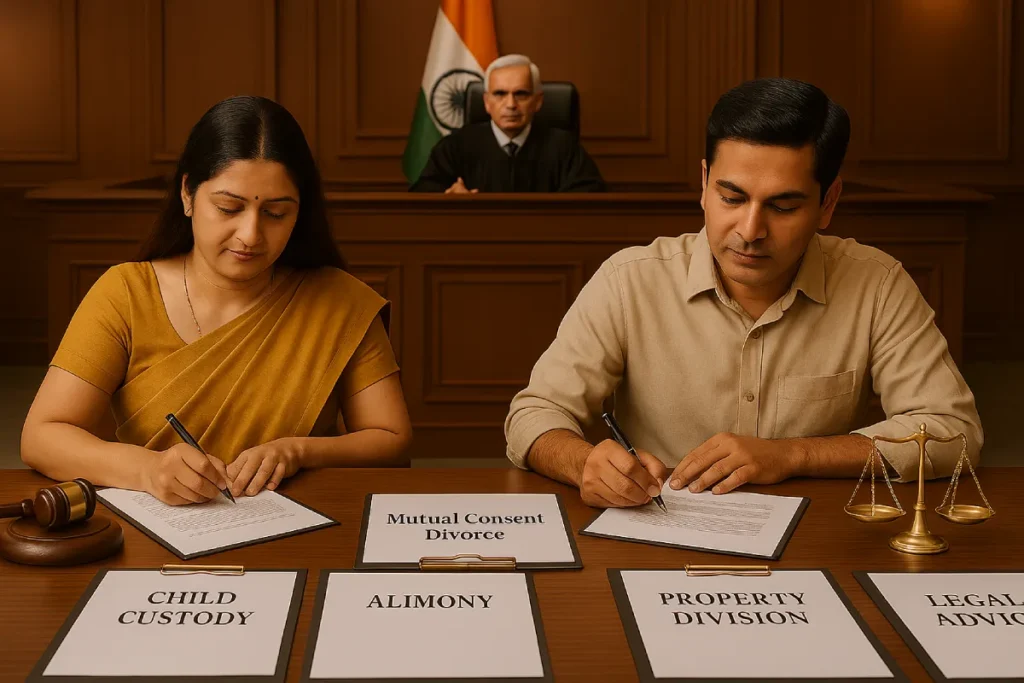Mutual Consent Divorce: Process, Eligibility & Legal Aspects
Mutual consent divorce is a type of divorce where both spouses agree to end their marriage and settle important matters such as alimony, child custody, and property division amicably. Unlike a contested divorce, where the divorce is initiated by one spouse and contested by the other, a mutual consent divorce allows for a faster, more peaceful separation when both parties are in agreement.
This form of divorce is governed by Section 13-B of the Hindu Marriage Act, 1955, and similar provisions under other personal laws such as the Special Marriage Act, 1954, and the Indian Divorce Act, 1869. In this blog, we will explore everything you need to know about mutual consent divorce, including its process, eligibility criteria, advantages, and legal considerations.
What is Mutual Consent Divorce?
A mutual consent divorce occurs when both spouses agree to dissolve their marriage and settle their differences without the need for prolonged litigation. Both parties must jointly file a divorce petition in family court, indicating their mutual agreement to separate and their decisions on key issues such as child custody, maintenance, and property division.
This type of divorce is quicker and generally more affordable than a contested divorce, as it avoids lengthy court battles and emotional disputes. The process is also less adversarial, which helps reduce the emotional stress typically associated with divorce.
The Process of Mutual Consent Divorce
The mutual consent divorce process is relatively simple and involves the following steps:
1. Filing the Joint Petition
The process begins when both spouses jointly file a petition in the family court. The petition will include details of the marriage, the reasons for seeking divorce, and their agreement on important matters such as alimony, child custody, and the division of property. This petition is signed by both parties, confirming their mutual consent.
2. First Motion Hearing
Once the petition is filed, the court will schedule the first hearing, also known as the first motion. During this hearing, the judge will verify that both spouses understand the terms of the divorce and are agreeing to the process voluntarily. If everything is in order, the court allows the divorce to proceed.
3. Cooling-Off Period
There is usually a mandatory six-month cooling-off period after the first motion. This period gives the couple time to reconsider their decision and allows for the possibility of reconciliation. However, in certain cases, this cooling-off period can be waived by the court if the couple is firm in their decision to divorce.
4. Second Motion Hearing
After the cooling-off period, the couple attends the second motion hearing. At this stage, both parties reaffirm their decision to divorce. If both still agree to the divorce, the court grants the divorce decree.
5. Final Decree of Divorce
The court issues the final divorce decree, officially ending the marriage. The divorce becomes legally binding, and both parties are free to remarry if they wish.
Eligibility for Mutual Consent Divorce
To file for a mutual consent divorce, the following eligibility criteria must be met:
- Separation Period: The couple must have been living separately for at least one year before they can file for a mutual consent divorce. This ensures that both parties have had time to reflect on the decision.
- Mutual Agreement: Both spouses must be in full agreement to the divorce and have settled key matters such as child custody, alimony, and the division of property.
- Voluntary Decision: The divorce must be voluntary, meaning neither party is being coerced or forced into the decision. Both parties must understand the legal implications of their actions.
- Joint Petition: The divorce petition must be filed jointly by both spouses in the family court.
Advantages of Mutual Consent Divorce
There are several advantages to choosing mutual consent divorce over a contested divorce:
- Faster Resolution: A mutual consent divorce can usually be completed within 6 months to 1 year, depending on the court’s schedule and whether the cooling-off period is waived.
- Cost-Effective: This type of divorce is more affordable compared to a contested divorce, as it requires fewer court hearings and legal procedures.
- Less Emotional Stress: Since both parties are agreeing to the terms, a mutual consent divorce is less emotionally taxing than a contested divorce. It helps reduce the animosity and stress that typically accompany a lengthy legal battle.
- Privacy: With fewer court hearings, mutual consent divorce tends to be more private and discreet, allowing couples to handle their separation without public exposure.
Key Legal Considerations in Mutual Consent Divorce
Although mutual consent divorce is a relatively simple process, there are important legal aspects to keep in mind:

- Child Custody: If children are involved, the court ensures that the custody arrangements are in the best interests of the child. Both parents need to agree on the custody or visitation terms before the divorce is finalized.
- Alimony and Maintenance: The spouses need to agree on the amount and duration of alimony or maintenance. This must be documented in the divorce petition and approved by the court.
- Division of Property: The couple must reach a fair agreement regarding the division of marital assets, including real estate, savings, and other investments.
- Legal Advice: While a mutual consent divorce is simpler, it is still advisable to consult with an experienced divorce lawyer to ensure that all legal requirements are met and that the divorce agreement is fair and legally binding.
Common Misconceptions About Mutual Consent Divorce
There are a few common misconceptions about mutual consent divorce:

- It’s Always Quick and Easy: While mutual consent divorce is faster than contested divorce, it still requires both spouses to agree on important issues. If there are disagreements, the process may take longer.
- No Court Intervention: Even though both spouses agree to the terms, the court’s role in verifying and approving the petition is crucial. The judge ensures that all legal requirements are met and that the divorce is granted fairly.
- Cooling-Off Period Can’t Be Waived: The cooling-off period can be waived in certain cases where both parties are firm in their decision to divorce. This waiver can speed up the process.
Let Us Help You Navigate Your Divorce Process
In conclusion, mutual consent divorce is an effective way for couples to end their marriage amicably, provided both parties are in agreement on the key aspects of the divorce. The process is quicker, more cost-effective, and less emotionally taxing compared to a contested divorce. However, it is important to ensure that all terms are properly agreed upon and legally documented to avoid complications later.
If you’re considering a mutual consent divorce, it’s always best to consult with an experienced divorce lawyer to guide you through the process. Contact us today for expert advice and legal assistance.







